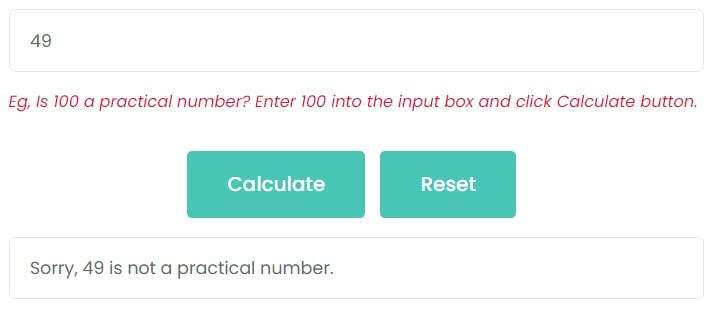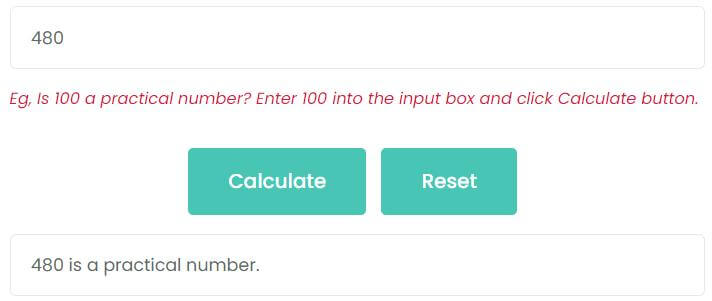Practical Number Checker is a free online tool used to check if the given number is a practical number.
What is a practical number?
A positive integer n is a practical number (also called panarithmetic number) if all the smaller positive integers can be stated as sums of distinct factors of n. It is defined by A.K. Srinivasan in 1948. Every power of two and every even perfect number is also a practical number. A practical number cannot be a deficient number.
For example, 16 is a practical number.
With the find all factors calculator, we can get that the factors of 16 are 1, 2, 4, 8, and 16. Numbers less than 16 and not factors of 16 are 3, 5, 6, 7, 9, 10, 11, 12, 13, 14 and 15. All of them can be stated as sums of distinct factors of 16.
3 = 1 + 2
5 = 1 + 4
6 = 2 + 4
7 = 1 + 2 + 4
9 = 1 + 8
10 = 2 + 8
11 = 1 + 2 + 8
12 = 4 + 8
13 = 1 + 4 + 8
14 = 2 + 4 + 8
15 = 1 + 2 + 4 + 8
So, 16 is a practical number.
First 100 practical numbers
- 1
- 2
- 4
- 6
- 8
- 12
- 16
- 18
- 20
- 24
- 28
- 30
- 32
- 36
- 40
- 42
- 48
- 54
- 56
- 60
- 64
- 66
- 72
- 78
- 80
- 84
- 88
- 90
- 96
- 100
- 104
- 108
- 112
- 120
- 126
- 128
- 132
- 140
- 144
- 150
- 156
- 160
- 162
- 168
- 176
- 180
- 192
- 196
- 198
- 200
- 204
- 208
- 210
- 216
- 220
- 224
- 228
- 234
- 240
- 252
- 256
- 260
- 264
- 270
- 272
- 276
- 280
- 288
- 294
- 300
- 304
- 306
- 308
- 312
- 320
- 324
- 330
- 336
- 340
- 342
- 348
- 352
- 360
- 364
- 368
- 378
- 380
- 384
- 390
- 392
- 396
- 400
- 408
- 414
- 416
- 420
- 432
- 440
- 448
- 450
How to use the practical number checker
The procedure to use the Padovan number checker is as follows:
- Enter the positive integer.
- Click Calculate button to verify whether the input integer is a practical number.
- Click the Reset button to start a new verification.
Solved examples using the practical number checker
Example 1: Is 49 a practical number?
Enter 49 into the input box and click Calculate button, as shown in the figure, 49 is not a practical number.

Example 2: Is 480 a practical number?
Enter 480 into the input box and click Calculate button, as shown in the figure, 480 is a practical number.

Latest Checkers
Check if the given number is an almost perfect number.
Latest Calculators
Standard Form to Slope-Intercept Form Calculator
Slope Intercept Form Calculator
Slope Calculator: Calculate Slope, X-Intercept, Y-Intercept
Reciprocal of Complex Number Calculator
Conjugate Complex Number Calculator
Modulus of Complex Number Calculator
Profit Percentage Calculator: Calculate Your Profitability Easily
Attendance and Absence Percentage Calculator